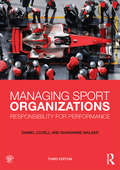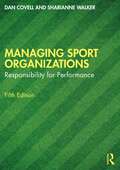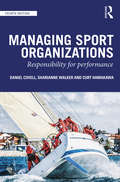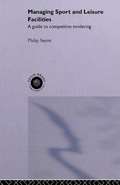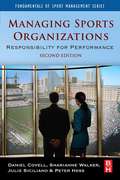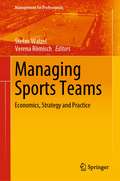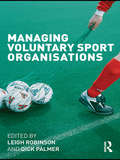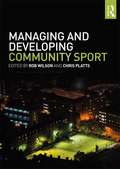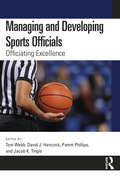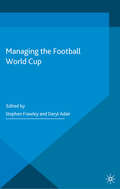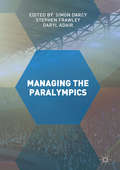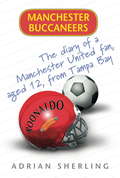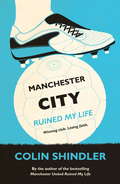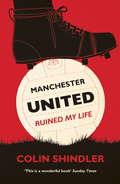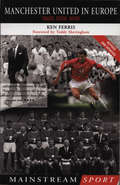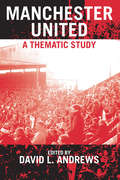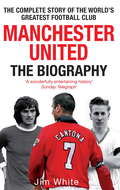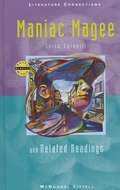- Table View
- List View
Managing Sport Organizations: Responsibility for Performance
by Daniel Covell Sharianne WalkerNow in a fully revised and updated third edition, Managing Sports Organizations is still the most interesting, challenging, and student-focused introduction to sport management currently available. Bridging the gap between theory and practice, this book explores every key topic, issue and concept in contemporary sport management, including: Understanding management and its relationship to sport The new sport management environment Decision making Strategy Organizational design Leadership Human resource management Managing change Facility management Innovation This new edition contains expanded coverage of current topics such as corporate responsibility and ethics, social media, career pathways in sport management, and international sport. Each chapter includes a full range of useful features, such as case studies, management exercises, study questions, and definitions of key terms and concepts. Managing Sports Organizations is the only book to fully introduce the core concepts and principles of management theory and to demonstrate their application in the contemporary sport industry. No other textbook combines the rigour of the business school with the creativity and dynamism of modern sport business. This is the perfect foundation text for any course in sports management, sports administration or sports organization.
Managing Sport Organizations: Responsibility for performance
by Sharianne Walker Dan CovellNow in a fully revised and updated fifth edition, Managing Sport Organizations introduces the fundamentals of sport management across every industry sector, from youth and intercollegiate sport to professional leagues, and from community-level sport to international sport.Bridging the gap between theory and practice, this book covers the key topics, issues, and concepts in contemporary sport management, and introduces the key skills needed to thrive as a successful sport management practitioner. It explores themes including strategy, decision making, leadership, human resource management, managing change, facility management, and sport media and technology, aswell as career pathways in sport management. This new edition contains expanded coverage of women’s sport, esports, artificial intelligence (AI) in sport, sustainability, and the structure and governance of international sport. Each chapter includes a full range of useful features, such as case studies, career insights, management exercises, study questions, and definitions of key terms and concepts.No other textbook combines the rigor of the business school with the creativity and dynamism of modern sport business, making this the perfect foundation for any course in sport management, sport administration, or sport business.This book is accompanied by ancillary materials including a test bank, presentation slides, and chapter outlines.
Managing Sport Organizations: Responsibility for performance (Fundamentals Of Sport Management Ser.)
by Daniel Covell Sharianne Walker Curt HamakawaNow in a fully revised and updated fourth edition, Managing Sport Organizations introduces the fundamentals of sport management across every industry sector, from youth and intercollegiate sport to professional leagues. Bridging the gap between theory and practice, it covers every key topic, issue and concept in contemporary sport management, including understanding management and its relationship to sport strategy decision making organizational design leadership human resource management managing change facility management sport media and new technologies This new edition contains expanded coverage of current topics such as international sport, ethics, new technologies and career pathways in sport management. Each chapter includes a full range of useful features, such as case studies, career insights, management exercises, study questions and definitions of key terms and concepts. No other textbook combines the rigor of the business school with the creativity and dynamism of modern sport business. Accompanied by additional online resources, this is the perfect foundation for any course in sport management, sport administration or sport business.
Managing Sport and Leisure Facilities: A guide to competitive tendering
by Philip SayersConcise and thoroughly detailed Managing Sport and Leisure Facilities is a clean operating guide to leisure management by contract, providing expert advice for both contractor and client. The author includes extracts from the relevant legislation and tender documents, and shows you how to submit a winning tender. He provides guidance on how to carry out customer surveys and also covers special items such as operating leisure facilities in hotels and sub-contracting catering services.
Managing Sport: Social and Cultural Perspectives (Foundations of Sport Management)
by David Hassan Jim LustedContemporary sport is shaped by wider society. Today those managing sport must be aware of the broader social and cultural context within which it exists if their effectiveness is to be established and their careers defined. This book is the first of its kind to contextualise the wider social and cultural environment of sport management and explain the key issues and practical implications of this for those working, or intending to find employment, in the field. Written by a team of leading international experts on sport management, the book explores important topics such as corporate social responsibility in sport, race, gender and sexuality, sport and the media, globalisation, populations with individual needs, social class, social capital social exclusion. As part of a comprehensive coverage of these and many other social issues, the reader is reminded of the fundamental requirement to properly appreciate the cultural sensitivities of the managerial environment in which they intend to operate. Each issue is examined from the perspective of the manager or sport practitioner, and each chapter includes a range of useful features, such as case-studies and self-test questions, to encourage the reader to think critically about the role of sport in society and about their own professional practice. This is the first sports management textbook to be based on the thesis that a more socially aware manager is a more effective manager and thus should be regarded as essential reading for all sport management students.
Managing Sports Organizations
by Daniel Covell Sharianne Walker Peter Hess Julie SicilianoManaging Sport Organizations, second edition, is a newly updated and comprehensive introduction to the themes and elements surrounding sport management. The book teaches management theory and principles in a coherent manner, helping to reinforce these concepts for students in schools of business, and serving to introduce them to students in other school settings (kinesiology, exercise science, sport science). The features of this book include: Important industry segment information is introduced chapter by chapter, allowing students to wed theory and application throughout Effectively weaves sport industry issues with fundamental management theories and practices Provides informative introductions to all fundamental aspects of sport management- Leadership, Information Technology, Media, Facility management, HR and much more With an online Instructor's Manual and a Test Bank available as well, this book is an essential tool for students and teachers of sport management.
Managing Sports Teams: Economics, Strategy and Practice (Management for Professionals)
by Stefan Walzel Verena RömischThis handbook offers a comprehensive overview of the most important and fundamental elements for the management of team sports organisations. It is intended to meet the needs of full-time and voluntary individuals in management positions in professional and semi-professional sports clubs, leagues and federations, and those who aspire to such positions. In addition to management-relevant aspects, its interdisciplinary approach also includes the basics of law and media, which are vital to the successful management of team sports organisations. Bringing together experts from the respective disciplines, the book’s content is presented in a clear and straightforward manner, facilitating its implementation in practice.
Managing Voluntary Sport Organizations
by Leigh RobinsonContemporary sport could not function without the involvement of voluntary organizations, from local grass-roots clubs to international agencies such as the International Olympic Committee. Management of this sector continues to undergo profound change, largely in response to the challenges of professionalization and increasing expectations in terms of transparency, accountability and ethical behaviour. This book fills a significant gap in the literature on sport management by setting out the principles and practices necessary for effective management of voluntary sport organizations around the world. In addition to applying and adapting established management strategies and techniques to voluntary sport organizations, this book is the first to fully relate mainstream organizational theory to this important sector of sport management. With contributions from an international team of researchers and management practitioners, the book explores key functional areas such as: governance strategy and planning human resources finance managing change marketing event management risk management. Each chapter discusses best practice and includes case study material, self test questions and guides to further reading. As the only book to outline a professional, theoretically informed and practically focused curriculum for voluntary sport management, this book is essential reading for all students of sport management and all managers working in or alongside the voluntary sector.
Managing and Developing Community Sport
by Rob Wilson Chris PlattsCan sport and physical activity (PA) be used to improve the communities we live in? How do community groups manage facilities that provide sport and PA? How can managers ensure the services they deliver meet the needs of their community? What role should community sport schemes play in society? Answer these questions and more in this, the first textbook to focus on the theory and practice of community-level sport management and development. Bringing together academics and practitioners with expertise in sport management, sport development, the sociology of sport, PA programming and community coaching, this book outlines best practice and explores contemporary issues relating to: Community enhancement through sport and PA Leadership, enterprise and innovation Budgeting and decision making Event and facility management Corporate social responsibility (CSR) Monitoring and evaluation. The book is divided into three sections: Part I provides an introduction to developing and managing community sport; Part II outlines the key issues and challenges that face those working in the sector; and Part III examines the leadership and management qualities needed to effectively manage and develop community sport. Insightful and user-friendly, Managing and Developing Community Sport is written in an easy to read style and is a vital resource for sport management practitioners or students hoping to work in community-level sport.
Managing and Developing Sports Officials: Officiating Excellence
by Pamm Phillips Tom Webb Jacob K. Tingle David J. HancockThis book offers an evidence-based guide to the development, management, and retention of sports officials. Drawing on research at all levels of sport, from grassroots to professional, this book focuses on best practices for sports officials and for anybody involved in the management or training of sports officials.This book is divided into three parts. The first takes a close look at who sports officials are, their motivations, and the formal and informal organizational relationships that define an official’s position in sport. The second examines the factors that can keep an official engaged in their sport, from building healthy cultures and good physical preparation to mentoring and mental health. The final part looks at the development of officials to elite level, including effective communication, improving decision-making, interpreting rules and laws, and career pathways. With case studies, real-life examples, and the voices of practicing officials included throughout this book, it introduces core concepts and best practices applicable across sports and different national and international contexts.This is an essential reference for all sports officials and for practitioners and policymakers working in sports organizations at all levels.
Managing the Football World Cup
by Stephen FrawleyManaging the Football World Cup explores areas often overlooked by project management and business studies researchers. Therefore considering the global impact of the Football World Cup it is time for a detailed examination of the planning, organization, management, implementation and related commercial features of this mega-sport event.
Managing the Olympics
by Daryl Adair Stephen FrawleyThe Olympic Games are the world's most complex and challenging sport mega-event to organize. Managing the Olympics is the first ever attempt to bring together the world's leading Olympic management researchers in one book and draws on the latest research into the management challenges faced by the organizers and key stakeholders of the Games.
Managing the Paralympics
by Simon Darcy Daryl Adair Stephen FrawleyThis book critically examines the planning, management, and operations of the world's premier event for Para sport athletes. Noting a lack of research into how these games are planned and managed, the authors of this contributed volume discuss how the Paralympics are essentially different to the Olympics and what this means for their management. Managing the Paralympics explores how the organizers and connected stakeholders effectively organize and deliver the Paralympics, taking into account what has been learned from previous events. Including emergent models of best practice from event management, project management and sport management literature, the book gives an insight into the planning of one of the world's biggest sporting events that encompasses ten impairment types and multiple sport classes within sports.
Manchester Buccaneers: The Diary of a Manchester United Fan, aged 12, from Tampa Bay
by Adrian SherlingA hilarious diary of a young American soccer fan, who supports Malcolm Glazer's new Manchester Buccaneers'My name is Roswell P. Shambling. I'm a 12-year-old Tampa Bay Buccaneers fan. I saw Malcolm Glazer bought EPL soccer side Manchester and they are now my favourite franchise. Manchester rules, man!'Roswell is an American youngster who likes Malcolm Glazer and has decided to support Manchester United (or Manchester as he calls them). From his home in Tampa, he follows all the latest developments of his new team, commenting on what he believes Sir Ferguson should do, worrying about Ferdinand Rio getting into a bar brawl in the northern English town of Sweden (and why would he be there when Manchester is in the south?), sadly watching his beloved Roy Keano leave and questioning why he never played for England, delighting in watching Manchester take on the Russian side London Chelseas and seeing the Roonaldo brothers succeed ... Roswell attempts to spread the word about Manchester and their successes and failures against teams such as Tott Nam, made up predominantly of young Vietnamese players, through his website, but unfortunately his thoughts are now always well received, with hilarious consequences...
Manchester Buccaneers: The Diary of a Manchester United Fan, aged 12, from Tampa Bay
by Adrian SherlingA hilarious diary of a young American soccer fan, who supports Malcolm Glazer's new Manchester Buccaneers'My name is Roswell P. Shambling. I'm a 12-year-old Tampa Bay Buccaneers fan. I saw Malcolm Glazer bought EPL soccer side Manchester and they are now my favourite franchise. Manchester rules, man!'Roswell is an American youngster who likes Malcolm Glazer and has decided to support Manchester United (or Manchester as he calls them). From his home in Tampa, he follows all the latest developments of his new team, commenting on what he believes Sir Ferguson should do, worrying about Ferdinand Rio getting into a bar brawl in the northern English town of Sweden (and why would he be there when Manchester is in the south?), sadly watching his beloved Roy Keano leave and questioning why he never played for England, delighting in watching Manchester take on the Russian side London Chelseas and seeing the Roonaldo brothers succeed ... Roswell attempts to spread the word about Manchester and their successes and failures against teams such as Tott Nam, made up predominantly of young Vietnamese players, through his website, but unfortunately his thoughts are now always well received, with hilarious consequences...
Manchester City Ruined My Life
by Colin ShindlerColin Shindler has previously written of his deep love for Manchester City in the bestselling Manchester United Ruined My Life and three other previous books. Now he tells the story of his sorrowful disenchantment with his home town club as, on the instruction of its new foreign owners, it turns itself remorselessly into a global brand. Trophyless since 1976, in 2011 Manchester City won the FA Cup and set off on their quest for the Premiership and the Champions League. In their zeal to win every competition the new Manchester City has spent money with wild abandon, signing outstandingly talented players as well as a few ordinary ones but in almost every case at hugely inflated prices. From the nail-biting win over Gillingham in the League Two Play Off final at Wembley in 1999 to the climax of the 2011 season, Shindler watches his team get steadily more successful and, to his own bewilderment, feels steadily more alienated from it. This is the story of a frustrated romantic who finds in the glitz and glamour of the current media-obsessed game a helter-skelter of artificially fabricated excitement. As he details how football courses through his veins Shindler tells how it intersects with his own life, a life that has been marked by family tragedy, and how he finally found personal redemption even as his team lost its soul.
Manchester City Ruined My Life
by Colin ShindlerColin Shindler has previously written of his deep love for Manchester City in the bestselling Manchester United Ruined My Life and three other previous books. Now he tells the story of his sorrowful disenchantment with his home town club as, on the instruction of its new foreign owners, it turns itself remorselessly into a global brand. Trophyless since 1976, in 2011 Manchester City won the FA Cup and set off on their quest for the Premiership and the Champions League. In their zeal to win every competition the new Manchester City has spent money with wild abandon, signing outstandingly talented players as well as a few ordinary ones but in almost every case at hugely inflated prices. From the nail-biting win over Gillingham in the League Two Play Off final at Wembley in 1999 to the climax of the 2011 season, Shindler watches his team get steadily more successful and, to his own bewilderment, feels steadily more alienated from it. This is the story of a frustrated romantic who finds in the glitz and glamour of the current media-obsessed game a helter-skelter of artificially fabricated excitement. As he details how football courses through his veins Shindler tells how it intersects with his own life, a life that has been marked by family tragedy, and how he finally found personal redemption even as his team lost its soul.
Manchester United Ruined My Life
by Colin ShindlerColin Shindler was dealt a cruel hand by Fate when he became a passionate Manchester City supporter. In this brilliant sporting autobiography he recalls the great characters of his youth, like his eccentric Uncle Laurence, as well as his professional heroes. Threaded through these sporting events is the author's own story, which touches on a universal nerve, growing up in a Jewish family, his childhodd destroyed by the sudden death of his mother and his slow emotional recovery through his love for Manchester City. It is a tale that reveals what it is like to be on the outside looking in, with his nose pressed up against the sweet shop window watching the United supporters take all the wine gums.
Manchester United Ruined My Life
by Colin ShindlerColin Shindler was dealt a cruel hand by Fate when he became a passionate Manchester City supporter. In this brilliant sporting autobiography he recalls the great characters of his youth, like his eccentric Uncle Laurence, as well as his professional heroes. Threaded through these sporting events is the author's own story, which touches on a universal nerve, growing up in a Jewish family, his childhodd destroyed by the sudden death of his mother and his slow emotional recovery through his love for Manchester City. It is a tale that reveals what it is like to be on the outside looking in, with his nose pressed up against the sweet shop window watching the United supporters take all the wine gums.
Manchester United in Europe: Tragedy, History, Destiny
by Ken FerrisManchester United's quest to win the European Cup was forged amidst the charred remains of an Elizabethan airliner that crashed on take-off at Munich's Riem Airport on 6 February 1958. Twenty-three people died in the tragedy, including eight of the famous Busby Babes. From that moment manager Matt Busby's goal of winning the European Cup became an obsession that permeated the whole club.Ten years after the Munich disaster, Busby achieved his dream when United - inspired by Bobby Charlton and George Best - beat Benfica 4-1 in extra time to lift the European Cup at Wembley. Some felt the ghosts of Munich were there to witness the club's joy. It seemed to be United's destiny finally to honour those who had lost their lives in pursuit of the gleaming silver trophy. But that triumph was to hang over the club for the next 31 years as United failed to regain those heights. Alex Ferguson's arrival spawned a flood of trophies, but the European Cup - by then known as the Champions League - remained elusively outside their grasp. Then came the last final of the twentieth century, against Bayern Munich in the towering splendour of Barcelona's Nou Camp, when United snatched a 2-1 victory from the jaws of defeat to complete the impossible Treble. Manchester United in Europe: Tragedy, Destiny, History recounts the course of those three European campaigns. Using first-hand accounts of the dramatic events, the book describes the sadness and the joy that have run through United's pursuit of European glory and considers the club's chances of ever repeating the European triumphs of the past.
Manchester United: A Thematic Study
by David L. AndrewsDespite myriad popular and journalistic expositions, up to this point there have been virtually no academic discussions of the Manchester United phenomenon. This anthology represents the first concerted academic examination of Manchester United F.C. in its current guise as a widely followed and highly emblematic sporting institution.Bringing together respected academics from an array of disciplinary backgrounds these essays each interrogate various related dimensions of the Manchester United world. The primary aim of this collection is to illustrate how the structure and experience of Manchester United is implicated in broader societal shifts, within which the boundary between cultural and commercial concerns have become increasingly indivisible.The chapters are presented within five thematic sections:1 Becoming United2 Economy United3 Embodied United4 Local United 5 Global United
Manchester United: The Complete Story of the World's Greatest Football Club
by Jim WhiteManchester United:The Biography will do for the football team what Peter Ackroyd did for London in his huge biog of the same name. The book follows the club?s extraordinary journey from its birth in the railway works of Newton Heath to its current status
Manchester United: The complete story of the world's greatest football club
by Jim White75 MILLION FANS. AN ANNUAL INCOME OF MORE THAN £200 MILLION. AND A STORY THAT HAS NEVER FULLY BEEN TOLD - UNTIL NOW. 'A wonderfully entertaining history' Sunday Telegraph 'When historians 1,000 years from now try to fathom the cult of Manchester United Football Club, White will be a good place to start' Financial Times MANCHESTER UNITED: THE BIOGRAPHY contains everything a football fan needs to know about the club, from its birth in the smog-bound mud of Newton Heath to the Theatre of Dreams. From the solid yeomanry of Lancelot Holliday Richardson, through the gilded days of Law, Best and Charlton, to the dazzling artistry of Cristiano Ronaldo dos Santos Averio and the pursuit of a record-equaling 18th League title. Award-winning journalist and lifelong red Jim White brings the history of this extraordinary club to life - unofficial and unbiased, it is written with the passion of a true fan.
Mandy Miller Fights Back (Sweet Valley Twins #48)
by Jamie Suzanne Francine PascalMandy Miller wants to join the Unicorns, but the Unicorns don't want Mandy Miller! She wears wild thrift-shop outfits, and the other members think she tries too hard to fit in. Jessica thinks she's funny and nice, and she likes her offbeat way of dressing. The Unicorns have asked Jessica to tell Mandy that she can't join, but Jessica just can't bring herself to break the bad news. How can Jessica be friends with the Unicorns and Mandy at the same time? Suddenly Mandy gets some frightening news that makes the Unicorns seem unimportant to both Mandy and Jessica -- and now Jessica is afraid of losing her newfound friend for good!
Maniac Magee and Related Readings (Literature Connections)
by Mcdougal LittellManiac Magee, winner of the 1991 Newbery Medal, is the story of a homeless young wanderer who can move like no one else the town has ever seen. "Maniac" Magee intercepts a football on a field of players twice his size, hits an inside-the-park home run without a baseball, and wins a race running backwards. Two challenges he can't outrun: the strong racial divisions in his hometown, and his need for a loving family.
